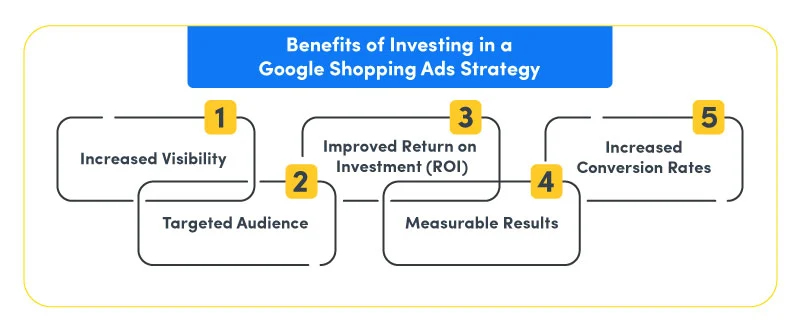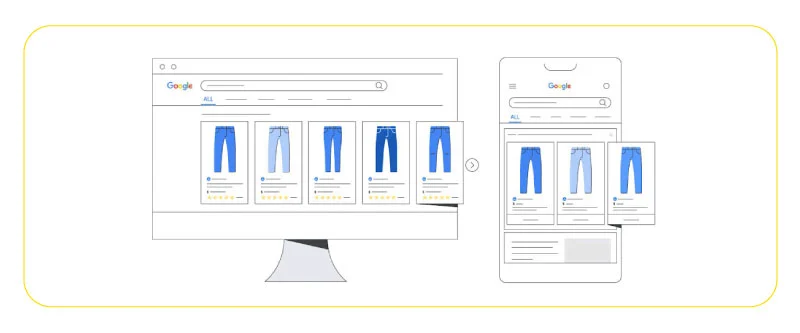Google Shopping Ads are a type of paid promotion that allows businesses to display their products as sponsored results on Google search engine result pages. With the rise of e-commerce, having a strong Google Shopping Ads strategy has become essential for businesses to reach their target audience effectively.

In this article, we’ll cover the basics of Google Shopping Ads, the benefits of using them, and the steps to crafting a successful Google Shopping Ads strategy for 2024. we’ll explore how you can use them to maximize your reach.
What are Google Shopping Ads?
Shopping ads are part of the Google Ads package that’s specifically created for e-commerce businesses. These ads have their own dedicated space, which is the “Shopping” tab in Google SERPs, but they can also appear on multiple other places like on Google’s search partner sites, Google Display Network, and even on top of the main search result pages. Shopping ads could be considered a subcategory of display ads. They contain images of the featured products alongside some basic info like price, store name, and star ratings.
The Benefits of Investing in a Google Shopping Ads Strategy
Google Shopping Ads offer several benefits to businesses, including increased visibility, better targeting, and higher conversion rates. By appearing at the top of search engine results pages, Google Shopping Ads can increase brand visibility and drive more traffic to your website. Additionally, Google’s targeting capabilities allow you to reach a specific audience based on factors such as location, search history, and device type. Finally, studies have shown that Google Shopping Ads can lead to higher conversion rates, as users are presented with more information about the product and can make a purchase directly from the ad.

One of the biggest benefits of using Google Shopping Ads is increased visibility. When a user searches for a product, your ad will appear at the top of the search engine results page, making it one of the first things they see. This increased visibility not only helps to drive more traffic to your website, but it also increases brand awareness and helps to establish your business as a trusted and reputable source for the products you offer. Additionally, the use of high-quality images and detailed product information in your ads helps to grab the attention of potential customers and increase their interest in your products.
The benefits of investing in a Google Shopping Ads strategy extend beyond just increased sales and revenue. When you run Google Shopping Ads, you are able to target specific demographics, geographic locations, and devices. This allows you to reach your target audience more effectively, increasing the likelihood that they will engage with your ad and make a purchase. Additionally, Shopping Ads also benefits from the tons of performance analysis and optimization features in the Google Ads package, providing you with valuable insights and data to tweak your campaigns and generate optimal results. With this information, you can continuously improve and refine your Google Shopping Ads strategy, making it an even more valuable investment for your business.
| Benefits | Description |
|---|---|
| Increased Visibility | Google Shopping Ads appear at the top of search results, increasing the visibility of products and making it easier for potential customers to find them. |
| Targeted Audience | Google Shopping Ads allow for targeting specific audience segments, such as demographics, interests, and purchase behavior. |
| Improved Return on Investment (ROI) | By reaching a targeted audience, Google Shopping Ads can provide a higher return on investment than other advertising methods. |
| Measurable Results | Google provides detailed data and insights on ad performance, allowing for continuous optimization and improvement. |
| Increased Conversion Rates | Google Shopping Ads have been shown to result in higher conversion rates compared to other forms of advertising, due to their visual and interactive nature. |
Steps to Crafting a Successful Google Shopping Ads Strategy in 2024
In today’s digital landscape, having a strong online presence is crucial for businesses looking to reach their target audience and grow their sales. Google Shopping Ads are an effective way to do just that. As we head into 2024, there are several updates and changes to be aware of when crafting your Google Shopping Ads strategy.

Set clear goals and objectives
Before starting your Google Shopping Ads campaign, it’s important to define your goals and objectives. This will help you determine the type of products to promote, the target audience, and the budget. Your goals and objectives will also guide you in determining the success of your campaign.
Optimize your product feed
In order to run Google Shopping campaigns, you need to provide Google with a feed of your products through a Google Merchant Center account. There, you can create separate feeds for your different product groups either by uploading product sheets, fetching from your server or crawling your online store.
The product feed is the foundation of your Google Shopping Ads campaign. Unlike in Search Ads where you decide which keywords should trigger your ads, in Shopping Ads, the product specifications and information in your feed tells Google when to show your ads. It’s essential to ensure that the feed is up-to-date and accurately reflects the products you want to promote. Optimizing your product feed involves ensuring that the product titles, descriptions, and images are clear, concise, and of high quality.
Conduct keyword research
Conducting keyword research is crucial in determining the right keywords to target in your Google Shopping Ads campaign. Use tools such as Google’s Keyword Planner to identify keywords that have high search volume and low competition. This will help you reach your target audience more effectively.
Use negative keywords
In addition to targeting specific keywords, it’s important to also use negative keywords. Negative keywords are words or phrases that you don’t want your ads to appear for. This will help you avoid showing your ads to users who aren’t interested in your products.
Monitor and adjust your bids
Your bid is the amount you’re willing to pay for a click on your ad. It’s important to monitor and adjust your bids to ensure that you’re getting the most out of your budget. Use tools such as Google’s Bid Simulator to determine the optimal bid for each keyword.
Test and refine your strategy
Continuously test and refine your Google Shopping Ads strategy to ensure that you’re getting the best results. Try new targeting strategies, adjust your bids, and track your performance using tools such as Google Analytics. A big part of your optimizing efforts is testing out different combinations of creative assets and targeting properties against each other to find out which ones yield better results.
While this could be a time and budget-consuming approach, it’s crucial to make sure you’re getting the most out of your ad spending. A trick you could use to streamline this process is taking advantage of a Google Display Ads spy with Google Shopping support to discover how other advertisers in your niche are handling their campaigns and follow well-proven techniques.
Integrate Google Shopping Ads with other marketing strategies
Google Shopping Ads can be an effective standalone marketing strategy, but it’s also important to integrate it with other marketing efforts. This includes utilizing other paid advertising platforms, leveraging social media, and utilizing email marketing to reach your target audience. By utilizing a multi-channel approach, you can maximize your reach and drive more conversions for your business.
The Key Elements of a Successful Google Shopping Ads Campaign
Starting a Google Shopping Ads campaign can seem daunting, but with the right approach, it can be a powerful tool for businesses looking to increase their online visibility and reach more customers. A successful Google Shopping Ads campaign requires a well-thought-out strategy, careful attention to detail, and a willingness to experiment and adapt as needed. Here are the key elements that every successful Google Shopping Ads campaign should include:
- Optimized Product Feed: Unlike standard search ads that use keywords to match ads with relevant search queries, Google Shopping requires advertisers to enter a product feed in their Merchant Center accounts. This feed contains product data like price, offers, condition, and availability. Google’s algorithm then decides when and how to show product ads to users based on how relevant they are to what users search.
- Strategic Bidding: The bid is the amount you’re willing to pay for a click on your ad. It’s important to monitor and adjust your bids to ensure that you’re getting the most out of your budget. Using tools such as Google’s Bid Simulators can help you determine the optimal bid for each keyword and maximize the results of your campaign. Additionally, consider using automation tools to streamline the bidding process and make it easier to manage multiple campaigns. By combining these elements, you can create a successful Google Shopping Ads campaign that effectively reaches your target audience and drives conversions.

Strategies for Improving Your Google Shopping Ad Performance
When it comes to e-commerce advertising, having a successful Google Shopping campaign is essential for reaching potential customers and driving sales. However, competition is fierce, and to get ahead, you need to optimize and improve your Google Shopping ads. Here are two key practices you could follow to maximize the performance of your campaigns:
- Understanding Your Target Audience: One of the key components of a successful Google Shopping ad campaign is understanding who your target audience is and what they want. By conducting market research, you can gain insights into your customer’s needs and preferences, which can help you tailor your ads to their specific interests. This will not only improve your click-through rates but also drive more qualified traffic to your website.
- Utilizing Data Analytics: Data analytics is your best friend when it comes to improving your Google Shopping ad performance. By tracking and analyzing your ad performance, you can gain insights into what’s working and what’s not, and make necessary changes to your strategy. Use tools such as Google Analytics and other third-party platforms to monitor your ad performance and make data-driven decisions that will help you get ahead of the competition.

Conclusion
Google Shopping Ads are a powerful tool that can help e-commerce businesses grow and reach more potential customers. However, in order to fully realize the benefits of this advertising channel, it’s crucial to have a well-structured strategy in place. This includes researching your target audience, setting clear goals, optimizing your product data, and regularly monitoring and refining your campaigns. With these tips in mind, you can create a Google Shopping Ads strategy that helps you reach your e-commerce goals in 2024 and beyond.
FAQs
How are Google Shopping ads targeted?
Google Shopping ads are targeted based on factors such as the user’s location, search history, and device type. Additionally, you can target specific keywords to reach your desired audience more effectively.
How do I structure a Google Shopping campaign?
To structure a successful Google Shopping campaign, you should start by defining your goals and objectives, optimizing your product feed, conducting keyword research, using negative keywords, monitoring and adjusting your bids, and continuously testing and refining your strategy.
How do I track the performance of my Google Shopping Ads?
You can track the performance of your Google Shopping Ads using tools such as Google Analytics. It’s important to continuously test and refine your strategy to ensure that you’re getting the best results.
How do I target the right audience with my Google Shopping Ads?
Google’s targeting capabilities allow you to reach a specific audience based on factors such as location, search history, and device type. Additionally, conducting keyword research and using negative keywords can help you reach your target audience more effectively.
How do I get started with Google Shopping Ads?
To get started with Google Shopping Ads, you need to set up a Google Merchant Center account and create a product feed. You’ll also need to link your Merchant Center account to your Google Ads account to create and run your ads.







 Facebook Ads Spy Tool
Facebook Ads Spy Tool TikTok Ads Spy Tool
TikTok Ads Spy Tool